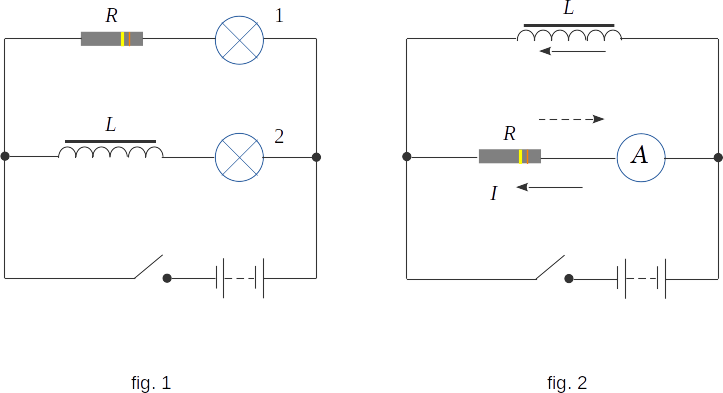From the Electromagnetic induction
138. Self-induction
If there is an alternating current on the coil, the magnetic flux that permeates the coil changes. Therefore, an EMF induction occurs in the conductor itself, along which the alternating current flows. This phenomenon is called self-induction. In self-induction, the conductive circuit plays a dual role: a current flows through the conductor causing the induction, and the EMF induction appears in it. A changing magnetic field induces EMF in the conductor itself along which the current flows and creates this field.
According to the Lentz law, at the moment of current rise the strength of the vortex electric field is directed against the current. Therefore, at this point the vortex electric field prevents the current from rising. On the contrary, at the moment the current decreases, the vortex electric field supports it.
This means that when a circuit containing permanent EMF closes, a certain value of current force is set not immediately, but gradually over time (fig. 1). On the other hand, when an EMF source is switched off, the current in the circuit does not stop immediately. The resulting EMF self-induction may exceed the EMF of the source, because the change in current and its magnetic field is rapid.

The phenomenon of self-induction can be observed in simple experiments. Figure 2 shows a diagram of two identical light bulbs working in parallel. One of them is directly connected to the source through resistance \(R\) and the other is connected in series with a large coil \(L\) on an iron core. The first bulb will flash almost immediately after the key is closed, and the second bulb will flash with a noticeable delay. The EMF self-induction in the circuit of this light bulb is large, and the current force does not immediately reach its maximum value.
A circuit diagram that allows you to observe the EMF self-induction when the circuit opens is shown in Figure 3. When the key is open, an EMF self-induction is occurring in the coil to support the initial current. Therefore, at the moment the key is opened, a current (dotted arrow) flows through the galvanometer, which is directed against the initial current prior to the opening. And the force of this current exceeds the current passing through the galvanometer when the circuit is closed. This means that the \(\Large{\varepsilon}\small{_i} > \Large{\varepsilon}\) batteries.
The analogy between self-induction and inertia.
The phenomenon of self-induction is similar to the phenomenon of inertia in mechanics. As a result of inertia, the body does not instantly acquire a certain speed under the action of force, but gradually. The body cannot slow down immediately, no matter how great the braking force is. Similarly, due to self-induction when the circuit is closed, the current force does not immediately gain a certain value, but increases gradually. When the circuit is opened, the current force does not disappear immediately. Self-induction keeps it going for a while despite the resistance of the circuit.
Further, in order to increase the speed of the body, according to the laws of mechanics, it is necessary to perform the work. When braking, the body does the work itself. In the same way, to create current, the work against a vortex electric field should be done. When the current decreases, this field does the positive work itself.